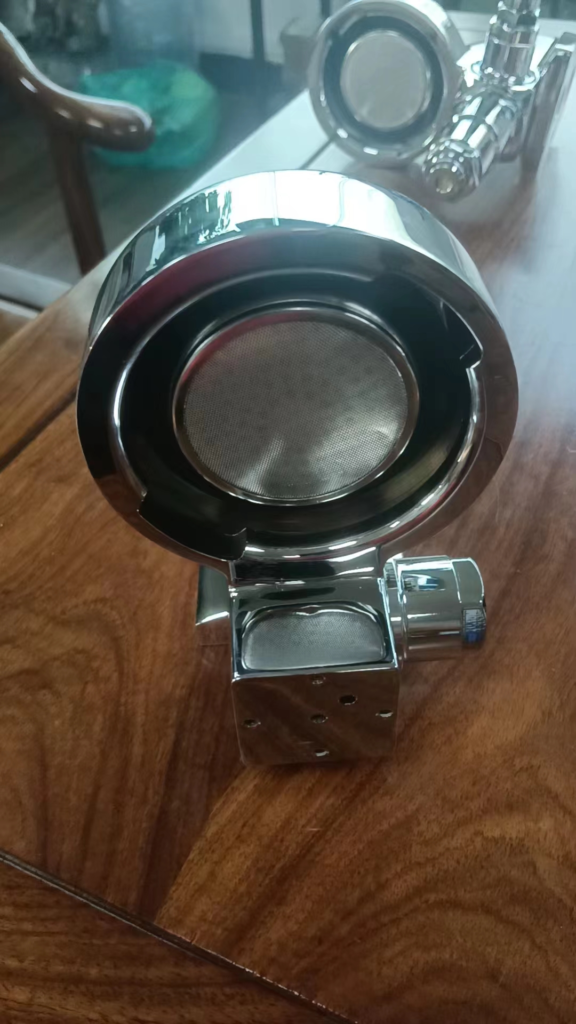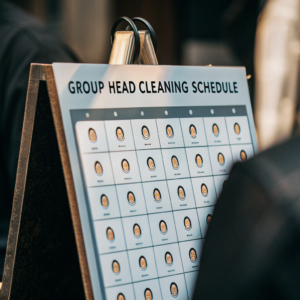How Does Regular Group Head Maintenance Impact Your Coffee Quality and Machine Longevity?
Your espresso machine is acting up. Shots taste bitter, extraction is uneven, and pressure seems inconsistent. These problems might stem from one overlooked component: your group head.
Regular group head maintenance is essential for quality espresso. By cleaning and maintaining this crucial component every 1-2 weeks, you'll prevent coffee oils and residue buildup that affects flavor, ensure even water distribution, and extend your machine's operational lifespan.

I've been in the coffee equipment business for over a decade, and I can tell you that most baristas don't realize how much their machine's performance depends on group head[^1] condition. Many coffee shops call me about "broken machines" when simple maintenance would solve their problems. Let me show you why group head care matters and how to do it right.
What Exactly Is the Group Head and Why Is It So Important?
The group head is causing problems for your coffee. Shots taste inconsistent, and you're not sure why. Understanding this critical component might be the solution you need.
The group head is the connection point where water meets coffee during extraction. It consists of the portafilter[^2], shower screen, dispersion block, and gasket that work together to create the optimal environment for even water distribution and proper extraction pressure.

A Closer Look at Group Head Components
The group head system is more complex than many realize. Each part plays a specific role in the extraction process:
| Component | Function | Maintenance Need |
|---|---|---|
| Portafilter | Holds the coffee basket and locks into group head | Regular cleaning to remove coffee oils |
| Shower Screen | Distributes water evenly over coffee puck | Weekly removal and cleaning |
| Dispersion Block | Breaks water flow into even pattern | Monthly deep cleaning |
| Group Gasket | Creates water-tight seal | Replace every 6-12 months |
| Group Head Body | Houses internal channels and valves | Backflushing with proper detergent |
I once visited a café where the owner complained about inconsistent shots. When I checked their machine, the shower screen was so clogged with coffee oils that water was only coming through three small spots! After a proper cleaning, their extraction immediately improved, and customers even commented on the better taste. This demonstrates how significantly these components affect your final cup.
The water path through the group head is designed to create optimal brewing conditions, but this can only happen when all parts are clean and functioning properly. Think of your group head as the final gateway that determines whether all your careful coffee selection and grinding work pays off in the cup.
How Often Should You Clean Your Group Head?
You notice your shots pulling unevenly. The taste has become bitter and extraction times are inconsistent. These problems often stem from neglecting your group head cleaning schedule.
A commercial espresso machine needs daily basic cleaning, weekly deep cleaning of the shower screen and dispersion block, and monthly complete disassembly of group head components to prevent buildup and ensure optimal performance.

The Impact of Different Cleaning Schedules
The frequency of your group head maintenance directly affects your coffee quality and machine performance. I've documented these effects across hundreds of café visits:
| Cleaning Frequency | Observable Impact | Long-term Effect |
|---|---|---|
| Daily (backflush with water) | Prevents immediate oil buildup | Maintains day-to-day consistency |
| Weekly (remove shower screen) | Ensures even water distribution | Prevents channeling in extraction |
| Monthly (deep clean with detergent) | Removes accumulated residue | Maintains proper flow rate and pressure |
| Quarterly (descale) | Prevents mineral buildup | Extends heating element life |
| Never/Rarely | Bitter taste, uneven extraction | Component failure, expensive repairs |
I recently consulted for a busy coffee shop that was cleaning their group heads only when they "looked dirty." Their maintenance log showed cleaning approximately every three weeks. We implemented a strict daily backflushing regime and weekly deep cleaning schedule, and the results were immediate. Their consistency improved dramatically, customer complaints about bitter coffee vanished, and they actually reduced their coffee waste by 8% because fewer shots were being rejected by baristas.
Temperature stability is another critical factor affected by group head cleanliness. Coffee oils and mineral deposits act as insulators, causing temperature fluctuations that are difficult to detect but significantly impact extraction. By maintaining a clean system, you ensure that your carefully calibrated brewing temperature remains consistent throughout the day, especially during high-volume periods when the machine is under stress.
What Are the Signs That Your Group Head Needs Cleaning?
Your coffee tastes off and shots pour irregularly. The machine seems slower to build pressure. These symptoms typically mean your group head needs immediate attention.
Signs of a dirty group head include coffee that tastes bitter or burnt, uneven extraction with channeling visible in used pucks, decreased water flow rate, difficulty reaching proper brewing pressure, and visible coffee residue on the shower screen or dispersion block.

Recognizing Deteriorating Performance Before Failure
Most baristas don't realize how gradually performance declines, making it difficult to spot problems until they become severe. Here are the progression stages I've observed across hundreds of machines:
| Stage | Observable Symptoms | Underlying Issue | Action Needed |
|---|---|---|---|
| Early Warning | Slightly bitter aftertaste, minor flow inconsistency | Initial oil buildup on shower screen | Basic backflush with water |
| Moderate Problem | Visibly uneven extraction, channeling in pucks | Partial clogging of dispersion holes | Remove and clean shower screen |
| Advanced Issue | Significantly reduced flow rate, sputtering | Heavy buildup affecting water pathways | Deep clean with detergent, disassemble components |
| Critical Failure | No/minimal water flow, pressure problems | Complete blockage or component damage | Professional service, possible part replacement |
The relationship between cleanliness and extraction is particularly evident in pressure profiling. On a clean group head, pressure builds evenly during pre-infusion and maintains stability throughout extraction. With a dirty group head, you'll notice pressure fluctuations and an inability to maintain target pressure, resulting in under-extracted or over-extracted shots.
A client of mine was convinced their expensive pressure profiling machine was malfunctioning. They were ready to request warranty service when I suggested a thorough group head cleaning first. After disassembling and properly cleaning all components, the pressure stability issues disappeared completely. What they had interpreted as an electronic control problem was simply the machine struggling to maintain pressure through partially clogged pathways.
Temperature stability also suffers with dirty group heads. You might notice that the first shot after machine idle tastes different from shots pulled during continuous service. This inconsistency often results from coffee oils affecting heat transfer within the group head components.
What's the Proper Method for Group Head Cleaning?
Your coffee machine needs attention but you're not sure where to start. Following a systematic cleaning process will restore optimal performance and flavor quality.
The proper group head cleaning method involves daily backflushing with water, weekly backflushing with proper espresso machine detergent, regular removal and cleaning of the shower screen and dispersion block, and periodic replacement of the group gasket.

Detailed Cleaning Procedure for Optimal Results
A thorough group head cleaning process requires attention to detail and the right tools. Based on my experience working with hundreds of cafés, this comprehensive approach yields the best results:
| Cleaning Step | Tools Needed | Frequency | Common Mistakes |
|---|---|---|---|
| Backflush with water | Blind basket, portafilter | Daily (end of shift) | Using too little water, insufficient cycles |
| Backflush with detergent | Chemical-specific blind basket, approved detergent | Weekly | Using too much chemical, improper rinsing |
| Shower screen removal | Flathead screwdriver, cleaning brush | Weekly | Forgetting to check gasket condition |
| Dispersion block cleaning | Allen wrench/hex key, soaking solution | Monthly | Not soaking long enough to dissolve oils |
| Gasket replacement | Gasket removal tool, new gasket | Every 6-12 months | Installing incorrectly, forcing components |
The choice of cleaning chemicals[^3] matters significantly. I've seen machines damaged by harsh chemicals not designed for espresso equipment. Always use detergents specifically formulated for coffee equipment - they're engineered to dissolve coffee oils without harming gaskets, seals, or metal components.
Water quality plays a role in maintenance frequency as well. Machines operating with hard water require more frequent descaling of internal components. I recommend installing a water filtration system[^4] calibrated to your local water profile - this investment pays for itself by reducing maintenance needs and extending machine life.
I once worked with a café chain that implemented a QR code system on each machine linking to video tutorials for proper cleaning procedures. This eliminated variations in cleaning technique across their locations and resulted in 23% fewer service calls for group head issues. Their approach demonstrates how standardizing maintenance procedures[^5] can dramatically improve outcomes.
How Does Group Head Maintenance Affect Your Bottom Line?
You're spending more on coffee beans and machine repairs. Your customers occasionally complain about inconsistent taste. These problems directly impact your profitability and reputation.
Regular group head maintenance reduces operating costs by minimizing coffee waste from rejected shots (typically 5-10% improvement), extending expensive component lifespan by 2-3x, decreasing service call frequency by up to 40%, and improving customer satisfaction through consistently better-tasting coffee.

The Financial Impact of Preventive Maintenance
The business case for regular maintenance is compelling when you analyze the numbers:
| Cost Factor | Without Regular Maintenance | With Regular Maintenance | Potential Savings |
|---|---|---|---|
| Coffee Waste | 8-12% of beans used in rejected shots | 3-5% wastage rate | $1,200-2,400/year for medium café |
| Repair Costs | Average $800-1,200 annually per group | $200-400 in preventive service | $600-800 per group annually |
| Component Replacement | Gaskets, shower screens every 3-4 months | Replacement every 6-12 months | $150-300 per group annually |
| Machine Lifespan | 5-7 years before major rebuild | 8-12 years of optimal performance | $1,000-2,000 amortized annually |
| Drink Quality Consistency | Variable, affecting customer return rate | High consistency, building loyalty | Difficult to quantify but significant |
I worked with a multi-location coffee business that was experiencing inconsistent performance across their shops. After implementing standardized group head maintenance protocols, they tracked their results over six months. The location with the most rigorous adherence to the maintenance schedule showed a 7.3% reduction in coffee usage while serving the same number of customers - meaning they were wasting less coffee on rejected shots.
Beyond the direct financial impact, there are operational benefits that affect your workflow. A well-maintained machine is more predictable, allowing baristas to achieve consistent extraction parameters without constant adjustment. This reduces the time spent dialing in and troubleshooting, especially during busy periods when efficiency matters most.
Customer perception represents another critical factor. In specialty coffee businesses, consistency is a key differentiator. I've consulted with cafés that implemented proper maintenance programs and subsequently saw improvements in their online reviews specifically mentioning consistent quality - demonstrating how technical maintenance directly affects customer experience and perception.
Conclusion
Regular group head maintenance is essential for quality coffee and machine longevity. By implementing proper cleaning routines, you'll enjoy consistent flavor, reduce repair costs, and extend your equipment's life - ultimately improving both your coffee and your bottom line.
[^1]: Understanding the group head's role can enhance your coffee-making skills and improve machine performance.
[^2]: Discovering the function of a portafilter can elevate your coffee brewing technique and machine maintenance.
[^3]: Explore this link to discover the most effective cleaning chemicals specifically designed for espresso machines, ensuring optimal performance and longevity.
[^4]: Learn how a water filtration system can enhance your espresso machine's performance and reduce maintenance costs, making it a smart investment.
[^5]: Find out how standardizing maintenance procedures can lead to significant improvements in service efficiency and machine reliability.



